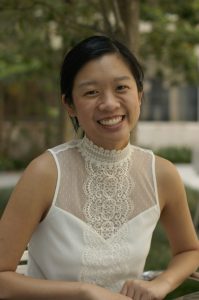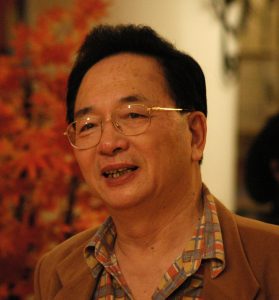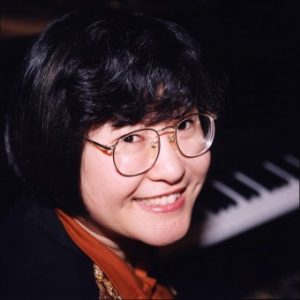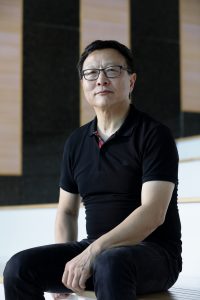
by Crystal Wu, BMus ’13, Arts Everywhere Marketing & Development Communications Manager
In one of my music classes in graduate school, I had a professor who referred to some of the most famous classical pieces as “money tunes.” This brings me to my first game-show-esque challenge for you. If I were to ask you to name 3 classical “money tunes” and the composer who wrote them in 30 seconds, could you do it? I imagine you might quickly spit out pieces like Beethoven’s Fifth Symphony, Mozart’s Eine kleine Nachtmusik, or Pachelbel’s Canon in D… and with time to spare. But what if I followed up with this bonus challenge: in 10 seconds, can you name ONE classical piece – it does not have to be a “money tune” – by an Asian composer? It’s a little harder, isn’t it? Maybe the opera Madame Butterfly comes to mind… but oh, wait! That one is not by an Asian composer. Well, speaking of butterflies, how about the Butterfly Lovers Concerto? But who wrote that piece…?
Everyone has different experiences and backgrounds, and I do not want to generalize or assume what people know or do not know. Instead, I will focus on what I know from my experiences and provide a few of my initial starting points of discovery.
I am a proud Asian-American who has been involved in music from the age of four and who now has a doctorate in piano performance and piano pedagogy. You might think: “she must be very familiar with Asian composers because she herself is Asian and she is involved in the music world.”
But being Asian does not mean I have had the good fortune to learn about “Asian music” in my studies. Being Asian does not mean I am more well-versed in it. Being Asian does not mean that I have inherently sought out “Asian music” my whole life.
In my many years of training as a classical pianist, my studies were almost always centered on composers of the Western musical canon. There is such breadth and depth to the piano repertoire that even tackling a small portion of these pieces is daunting. I still have hundreds of pieces on my bucket list that I want to play, and yes, a large majority of them do come from the Western canon. While I enjoy and make a point to find and perform pieces that are less well-known, I have only had a few brushes with music by Asian composers.
In my academic music studies (I was and am a big nerd for music history and theory), if the topic of Asia came up in a music history book, it would often be on how Asian culture or music influenced Western composers, such as when John Cage used the I-Ching to influence his work or how Henry Cowell used the concept of tala in his music. The other point of reference would be on the use of the pentatonic scale and unique instruments – unique because they were not common to Western music – in “Asian music.” While the pentatonic scale and use of these instruments are characteristic of traditional “Asian music,” must all composers of Asian descent use these elements when creating their music?
It seems that as society is becoming more aware for the need to be more inclusive, to add more voices to the traditional canon, the first pieces and composers that are chosen are ones that include stereotypical musical elements that are associated with the countries or cultures in which they are from. They have that sound that is “different” than traditional Western music.
All that to say, when asked to share my thoughts with the DWW series for Asian American and Pacific Islander Heritage Month, I was very honored to be asked but also felt quite unsure about where to start. Do I write about composers that have a distinctly Asian-sounding style? How do I represent “Asian music” in one article? If I had been asked to write on the history of piano music and its development throughout different musical time periods… piece of cake! But my knowledge on the subject of “Asian music” is quite limited. While I could speak to my experience as an Asian-American in the music world, I cannot speak with much authority on “Asian music.” But I realized that this is okay. My circumstances, my training, my upbringing, and so many factors led me to where I am now but it does not mean that I am done learning. I want to learn more. I want to do the work.
A quick sidenote: I keep putting “Asian music” in quotes because Asia, the largest and most populous continent on our planet, encompasses so many rich cultures and traditions that it is almost unfair and impossible to represent them all in this article. My family is from Taiwan and before that from China, so I admit I have my own biases because when I think of “Asian music,” my mind gravitates there. But “Asian music” encompasses so much more than one culture – Chinese musical traditions are vastly different from the musical traditions of Japan, which are different from the musical traditions of India, which are different from the musical traditions of the Philippines, which are different than the musical traditions of Iran, which are different than the musical traditions of Indonesia, and the list goes on and on.
For me and perhaps for many people out there, it can be a daunting task to know where to start but the key is to just get started. Start somewhere and see where you go. Find a seed and go down that rabbit hole. I decided to start with what I already know – my heritage, my background, and my pianistic outlook on the musical world – and work out from there to enhance my own knowledge and to add to my bucket list of pieces I want to play. Below you will find my seeds of discovery and my initial journey into the rabbit hole of Asian composers and pieces.
This is just the start of my own work into exploring composers of Asian heritage. It feels like a drop in the bucket (or a drop in an endless ocean), but we all must start somewhere, to begin filling our buckets and expanding our knowledge and awareness.
Butterfly Lovers Concerto
To come full circle and to make sure I do not leave anyone hanging, The Butterfly Lovers Concerto was written by two composers, Chen Gang and He Zhanhao, who were both students at the Shanghai Conservatory of Music and composed the piece collaboratively. I first heard of this piece when my cousin performed it at her high school senior recital. Since then, my husband, a violinist, and I have tried to sight read it together. We look forward to exploring the piece more together in the future!
A little about the composers

Chen Gang was born into a musical family and eventually attended the Shanghai Conservatory. Later in life, he taught harmony and composition on the school’s faculty, directed the Shanghai Chamber Music Ensemble, and served as president of the Chinese Musicians’ Society. He Zhanhao grew up immersed in folk music and yueju (Shaoxing opera) and became a violin major at the Shanghai Conservatory. In an interview in 2000 he recalled:
“But, I asked, who am I studying this for? Am I going to play Bach and Beethoven for the peasants? … I ask if they understand, they all say no. But they love to hear yueju! … So this influenced our thinking — how could we use folk music with the violin? How could we nationalize the violin?”
His solution to his question? By using extended techniques on the violin to recreate characteristic gestures and sounds associated with other Chinese instruments throughout the Concerto.
More information
- Read more about the composer and piece in the New York Philharmonic’s program notes here.
- To hear the Concerto, check out this performance played by Carolina Performing Arts and UNC Music favorite, Gil Shaham.
- Then compare and contrast that performance to this version where the piece is performed on erhu, a two-stringed bowed musical instrument sometimes known in the Western world as the Chinese violin or a Chinese two-stringed fiddle.
Masayuki Nagatomi
The next thread I decided to pull at was a piece that I was first introduced to in graduate school: Trois Esquisses by Masayuki Nagatomi. My piano teacher had discovered it when preparing for a recording project he was working on and shared the piece with me. Learning the piece was both a fun and challenging experience. Although I never performed it in a recital, it is a piece I hope to program one day. Interestingly, information on Nagatomi and the piece itself is quite scarce. The lack of available information is a good reminder that there is so much music out there waiting to be discovered, waiting to be researched, and waiting to be analyzed.
A little about the piece
What I know is from having worked through some of the piece and studying the score. The set is separated into 3 short movements: Aire, Feu, and Eau et Terre (“Air,” “Fire,” and “Water and Earth”). Written without a meter, each movement uses distinct rhythmics gestures, timbres, and motives to capture the appropriate imagery of the title. The movements do not seem to feature the “traditional” markers of “Asian music” and are instead characterized by dissonance and atonal passages more akin to the music of George Rochberg.
More information
- Listen to one of the few recordings available on YouTube
Chen Yi

The next seed I decided to explore is the music of Chen Yi. While I was a pianist for a church choir, our choir director, an amazing musician and a constant source of inspiration for me, actively sought to present diverse selections of music to the congregation. That is where I first heard of Chen Yi. We did a fun song called Diu Diu Deng (which is an acapella song so not much work for me there) but I listened (and plunked out notes) in awe as the choir recreated the mechanical sounds of a train in Diu Diu Deng. You can listen to a recording of the song here.
This imaginatively creative piece has stuck with me so I thought this could be a good starting place to delve deeper.
A little about the composer
Born in Guangzhou in 1953 into a cultured family (both her parents were medical practitioners and amateur musicians), Chen Yi took violin lessons as a child. When the Cultural Revolution began, she was sent to live in a rural area. Although the manual labor was tough, the contact with Chinese culture as maintained by peasants vastly enlarged her horizons and influenced her future work.
In an interview in 2001, the composer said,
“I also found my own language when I realized that my mother tongue really is the same as what the farmers speak! I also found that when I translated it into music, it’s not the same as what I was practicing every day! For this reason, I believe that I really need to study more deeply and extensively, and find a way to express myself in a way of real fusion of Eastern and Western music in my music. This result should be a natural hybrid, and not an artificial or superficial combination.”
As a pianist, I was curious to see if there were any piano pieces that I could explore or pieces that I could introduce to my students, as I would love to encourage the younger generations of pianists to widen their own lenses in their musical studies. That is when I came across Two Chinese Bagatelles.
Two Chinese Bagatelles: Yu Diao and Small Beijing Gong
Although written many years apart, these two pieces were published together as piano solo pieces for children. Yu Diao was inspired by the local opera of Henan Province. Yu refers to the Henan province; diao means tune. So the title Yu Diao means “tune from the Henan province.” In three sections, the musical characteristics throughout the piece allude to musical elements of Henan’s local operas, such as the style of singing dialogues and the use of pentatonic scales.
Small Beijing Gong is quite rhythmic, which drives the piece forward and features an ostinato bass in the first section of the piece. As a piano teacher, I could see myself using these pieces to introduce students to the sounds of Chinese Opera so they have a sense of what elements to imitate and what elements in the piece specifically allude to traditional Chinese sounds and music.
More information
- Listen to Yu Diao here
- Listen to Small Beijing Gong here
- Bonus piece: Memory for solo violin – listen here
- Memory was written for Chen Yi’s late violin teacher, Lin Yaoji. In the piece’s original program notes, the composer writes to her late mentor: “I wish you could hear the tune in my Memory, which sounds like my painful cry out of your name in our Cantonese dialect. I expressed my deep sorrow in the music, to remember your fatherly mentorship.”
Bright Sheng

Bright Sheng was a name that my husband suggested I include (part of doing the work is talking to those around you about it as well!) It turns out, Sheng did make it into Norton’s A History of Western Music, two pages before the glossary under the section titled “Interactions with Non-Western Musics”!
About the composer
The paragraph Norton included about Sheng describes how composers drew directly on Asian music to inspire their works. Sheng was born and trained in China and then moved to New York to continue his studies and “sought to integrate elements of Asian and Western music while respecting the integrity of each.” The example in the book cites his solo cello suite, Seven Tunes Heard in China (performed here by another CPA favorite artist, Yo-Yo Ma) in which Sheng combines the traditions of European classical music from Bach’s Cello Suites (sequences, double stops, and implied polyphony) with the playing style of Chinese bowed string instruments (marked by grace notes, glissandos, sudden dynamic changes, and flexible rhythms).
My Song and My Other Song
As a pianist, I wanted to find pieces closer to my realm of studies and that is when I discovered “My Song,” his first work for solo piano (which was commissioned and premiered by Peter Serkin). Seventeen years later, he wrote “My Other Song” to mark the change in his writing. Sheng says:
“In 1990, after eight years in the United States, I wrote my first work for solo piano, titled My Song, commissioned for Peter Serkin. At the time, my primary compositional concentration was to develop a melodic and harmonic style within the boundaries of Chinese folk music, which are mostly in pentatonic modes, and contemporary Western Classical music. As a result, all the four movements in My Song were either based on existing Chinese folk tunes or written in their style. I was asked recently by another virtuoso pianist friend, Yefim Bronfman, to write a work for solo piano. After the passing of 17 years, I wonder if there is any change in my writing. I therefore titled the new suite My Other Song. There are four movements in the composition, the first three of which are brief and provide contrast in character. The theme of the last movement, the longest, is based on a Buddhist chant heard at the wake for my mother in February 2005.”
More information
- Check out the composer’s website here: Bright Sheng
- Watch his TedxUofM talk: The last train: Bright Sheng at TEDxUofM
- Sheng talks about growing up in China, his experiences during the Cultural Revolution, and his life as a young composer in New York. He also talks about the joys and rewards of teaching and never giving up.
- At the end, Sheng performs a portion of My Song
- Watch the whole performance of My Song here
- Listen to My Other Song performed by Peter Serkin here
As I mentioned earlier, this is only a drop in the bucket, a sliver of a sampling of “Asian music.” However, I hope this article introduced you to composers or pieces that were unfamiliar to you and encouraged you to find your own points of access to start your own journey of exploration!
Discover more composers not known to you at Institute of Composer Diversity.
